- California High Speed Monorail System
- California High Speed Monorail-Southern Section
- California High Speed Monorail-Northern Section
- California High Speed Monorail-Los Angeles Region
- California High Speed Monorail-Bay Area
- California High Speed Monorail (red) & CHS Rail (blue & green)
The elegance and efficiency of the proposed 800-mile monorail system alternative to the high-speed rail project are exemplified by the juxtaposed route maps of the two systems; which delineate a relatively straight and direct 500-mile high-speed monorail system route between the San Francisco Bay Area and San Diego, and built completely within the center median of California’s Interstate 5 Freeway, compared with the far flung and erratic 800-mile route of the proposed California High-Speed Rail System. This comparison of routes and rights of way is just the beginning of the dramatic contrasts and differences between the steel rail and monorail proposals, which extend to every aspect of the respective plans’ engineering, development processes, rights of way, technology, efficiency, environmental impacts, energy use, economic impacts and domestic content, as well as, the systems’ short- and long-term financial profiles.
While the California High-Speed Rail system appears to be designed independently of other existing or planned transportation systems, development patterns or environmental settings, the American Monorail-proposed California Monorail System integrates inter-city, urban and major venue-serving monorails into a mutually supportive system of modern, environmentally enhancing, financially sound and self-perpetuating monorail services that are likely to serve as the most significant influences on their respective urban settings, industrial workforces, transportation environments, development patterns, public and private financial stability and urban planning processes throughout future decades.
American Monorail’s transportation infrastructure and system proposals present California government and industry, as well as communities and their local economies, with opportunities to transform and revive the basic foundations of urban living, economics and public services. By relieving government and taxpayers at all levels of the ever-increasing financial burdens of building, maintaining and funding mass transportation services, American Monorail proposes the comprehensive development of a monorail industry from research, development and manufacturing, to design, construction and operation of the world’s most advanced and efficient mass transportation systems.
Proposed Route Run Path Videos
Part 1 – San Diego to Coalinga
| 00:04 | Coronado Bridge, San Diego |
| 00:19 | San Diego Monorail Station (High Speed and Commuter Express) |
| 01:06 | Sorrento Valley Monorail Station (Commuter Express) |
| 02:24 | Oceanside Monorail Station (Commuter Express) |
| 03:45 | City of San Clemente |
| 04:11 | City of San Juan Capistrano |
| 04:35 | Mission Viejo Monorail Station |
| 05:14 | City of Irvine |
| 05:39 | Pomona to Anaheim Commuter Express Monorail |
| 05:43 | City Drive Monorail |
| 05:45 | California High Speed Monorail – ARTIC Connector |
| 05:51 | ARTIC – Disneyland Connector Monorail |
| 06:08 | Fullerton Monorail Station |
| 06:21 | Santa Fe Springs Monorail Station |
| 07:00 | Citadel Monorail Station |
| 07:21 | Los Angeles – Ontario Commuter Express Monorail Labeled as CHSM on Los Angeles to Las Vegas video |
| 07:22 | Downtown Los Angeles Monorail Station Connector |
| 07:29 | Los Angeles River Commuter Express Monorail |
| 07:37 | City of Glendale |
| 07:49 | Rose Bowl Commuter Express Monorail |
| 07:51 | Griffith Park Monorail Transfer Station |
| 07:53 | Santa Barbara Commuter Express to Ventura Monorail |
| 07:59 | Chatsworth Commuter Express Monorail |
| 08:00 | Burbank Monorail Station |
| 08:08 | Burbank Airport Monorail To the left of CHSM |
| 08:45 | Los Angeles Airport (LAX)- Santa Clarita Commuter Express Monorail |
| 08:49 | Roxford Monorail Station |
| 08:58 | Antelope Valley Commuter Express Monorail |
| 09:17 | Pico Canyon Monorail Station |
| 09:34 | Santa Clarita Monorail Station |
| 11:29 | Tejon Pass |
| 11:33 | Frasier Park Monorail Station |
| 12:05 | “The Grapevine” Note: This canyon is too steep for surface steel rail traffic. |
| 12:10 | Grapevine Monorail Station |
| 12:31 | U.S. Highway 99 Junction (to Bakersfield) |
| 19:17 | Harris Ranch Monorail Station |
Part 2 – Coalinga to San Francisco
| 02:48 | Pacheco Pass Monorail Station Proposed route for CHSRA route to San Jose |
| 05:24 | Interstate Highway I-580 Junction Monorail Station |
| 06:21 | Interstate Highway I-205 Junction |
| 07:00 | Livermore Monorail Station End of CHSM portion and beginning of East Bay Commuter Express Monorail route |
| 07:28 | Pleasanton Monorail Station |
| 08:07 | Redwood Monorail Station |
| 08:39 | Coliseum Monorail Station |
| 08:56 | Oakland |
| 09:13 | Bay Bridge Monorail Station |
| 09:40 | San Francisco Financial District End of route, approximately 500 miles from San Diego |

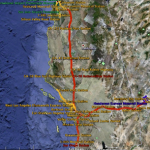
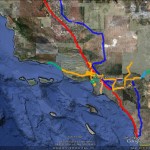
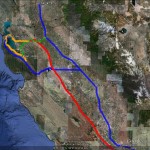
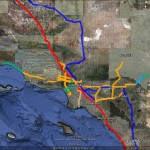
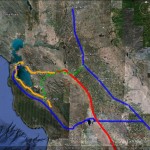
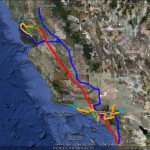




This is putting the cart before the horse. I am sorry, but planning routes for foreign companies does the American monorail no good. The best way, would be to push a company to produce small scale of a decent design and then get that sold with patents being obtained. Once you have it started on a small scale, then you can expand to larger systems.
Thank you, g.r.r., for your comment. If you read our “Blueprint for a New American Industry” article, you will come to learn of a process through which a US monorail industry that is 100% American is developed. As such, this nascent industry would push the state of the monorail industry well beyond its present international standing and be a boom to the U.S. economy, providing a significant number of new jobs.
Almost 50 years ago while attending the Mechanical Engineering Show in NYC I saw a demonstration of an underslung high speed monorail system by a company from Washington State. I was impressed then as I am now with the technology, that was 50 years ago and sad to say the technology has not been utilized to any great degree (tranportation wise) in our nation. Its benifits were apparent then as they are now but yet there is still resistance to its implimentation, can you or anyone else explain this. I think what you propose is a marvelous idea it addresses most if not all of the mass trasit problems within the state. I would if I had anything to do with its planning (I guess once an engineer always an engineer even though retired) see provisions for comercial container tranportation via the system.
This strikes me as a wonderful idea. I have discussed such a concept for some time here in Texas, but your project is much further along in its conception. Obviously, execution will be very challenging. I believe that a similar proposal would apply with equal validity here in Texas — connecting, Austin with Dallas to the north, San Antonio to the southwest, and Houston to the southeast, along the medians of I-35 and I-10. Presumably, and with appropriate federal/state involvement, the often prohibitively expensive cost of obtaining right-of-way either directly or by condemnation would be eliminated. The population densities and relative proximity of these cities to one another would lend themselves very well to such travel.
Does the high-speed monorail technology exist today to make such an enterprise feasible?
Assuming that the federal and state governments have neither the means nor the will to bring such a project off, but would welcome this boon to the infrastructure, I propose presenting a detailed plan to a private investor — such as Warren Buffett, who has the financial wherewithal and ought to see the benefits of building and owning such a system, If even Buffett might balk at a price tag perhaps north of $10 billion, he likely has a few colleagues who would be interested in investing. High speed rail was considered here in Texas several years ago; however, the fledgling Southwest Airlines — heavily dependent on the Dallas-Houston-Austin traffic — effectively killed the plan. Southwest is no longer a local airline fearful of such competition — or, at least, not so fearful as to present a formidable opposition, especially given all the benefits this project will bring to the environment and the economy.
I would be delighted to assist in helping to bring this project to completion and on-going success.